Items
Mediator is exactly
Black Voices
-
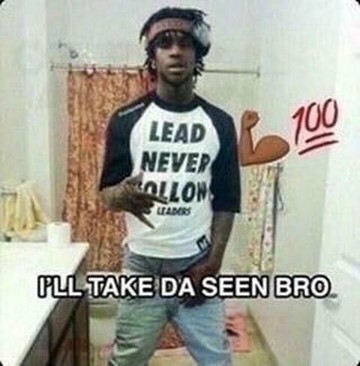 2023-12-14
2023-12-14Aaron Danner Professor Clarke Comp II 13 Dec. 2023 COVID-19 Archive Entries
During COVID, I unearthed some pre-existing online culture in certain spaces, like the larger Black online communities. With the pandemic especially disproportionately affecting communities of color, sometimes it could be fun to send photos back and forth, especially when there was nothing better to do. These entries into "A Journal of the Plague Year: The COVID-19 Archive" somewhat reflect my background (black, chronically online, good music enjoyer). Through careful consideration, the images above contribute to the COVID-19 Archive by centering on the Black online experience during the period. Entry 1: Photo - "I’ll take the seen bro" This photo, posted sometime in 2022, directly references group chat culture and highlights the isolation that such online social hubs sort of erased, to some degree, which provided an outlet from which experience further caused damaging effects. In the span of the 36-odd months between the start of covid 2020 and this time Fall of 2023, many things surrounding sociability changed. This entry envisions the underlying happy-sadness within the digital spaces at the time. We were thankful to have someone to share these posts with even if we couldn’t see them in real life. By the presumed “end” of COVID, many become “chronically online”, or at the least, the youth became even more enthralled with social media communities than before. Saying “I’ll take the seen” demonstrates a joking willingness to sacrifice one’s online profile (an exaggerated act) concerning group chat message viewing and response. Entry 2: Photo - Sosa in the Ukraine” Also from around 2022 (speculatively), entry #2 involves an enlarged edit of Chief Keef along over a cityscape with the caption “On the way to Ukraine 🚶💥🔫🏃♂️.” This edited image of Chief Keef (@chiefkeefsosa on Instagram) reflects on the early stages and meme culture of the COVID-19 period Ukraine conflict. The transcendent Chicago star posted this image as the conflict overseas began to heat up. During this time, the underlying danger of the war as well as the widespread long-term effects of the pandemic were still fresh on the internet. The post’s lighthearted attitude was quickly absorbed by the rest of the internet, where the image continued to circulate. Surely, future researchers will unearth photos like these in amazement at how simple memes assisted so many in pain during isolated periods. They helped maintain comedic and cultural connections despite physical distancing measures. Circulation and archival of images from the Black community, from the pandemic period, will provide a more complete record for the future.. The selected items offer a window into the complexities of the Black experience during the pandemic, shedding light on both the challenges faced and the enduring spirit of resilience and resistance that defines the Black community. Through these submissions, I invite a more comedic perspective of the socio-cultural impact of the pandemic, ensuring that this part of the COVID narrative won't be forgotten. -
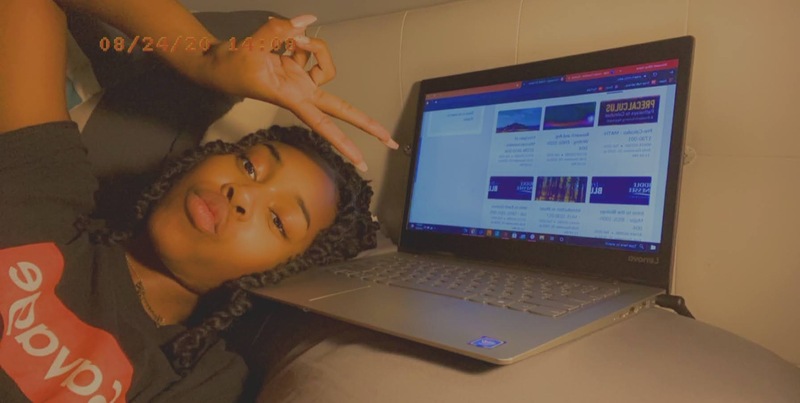 2020-08-24
2020-08-24First Day of School Picture
The picture I chose to add to the archive is my first day of school on August 24, 2020. In this picture, I was laying in bed with my laptop because everything was online. If you were lucky, you got a professor that taught class on Zoom. That is the closest to being in a regular classroom as it got. You were able to see your classmates (if they turned their camera on), you could have discussions with everyone, ask the professor questions and get immediate answers. On the other hand, you could get stuck with a professor who chose to use youtube videos and websites instead of teaching. These were the worst, poor to almost no teacher-student interaction, just discussion boards and Google. It was impossible for me to learn like this, I felt like I was not being taught! It was always stressful when trying to do assignments for classes like this because I did not understand the curriculum. If I needed to contact my professor, I just had to send an email and hope they would email me back soon with answers. Sometimes, I would not get a response until days later, a few times I never got a response. After a while of this, I started to feel miserable, stressed, and depressed. My grades started getting lower and lower and knowing how much school costs, knowing that I was going to lose my grants and scholarships because I was failing, I started having anxiety attacks. In my head, I kept saying, “I cannot learn like this, I know I am going to fail, so why keep trying?” Things got to a point where I would open my laptop, look at my assignments, cry, and then just close my laptop back up. I lost all my motivation and I lost sight of my dreams to be an optometrist. I remember the day that I dropped out, the defeat that I felt, feeling like a complete failure. -
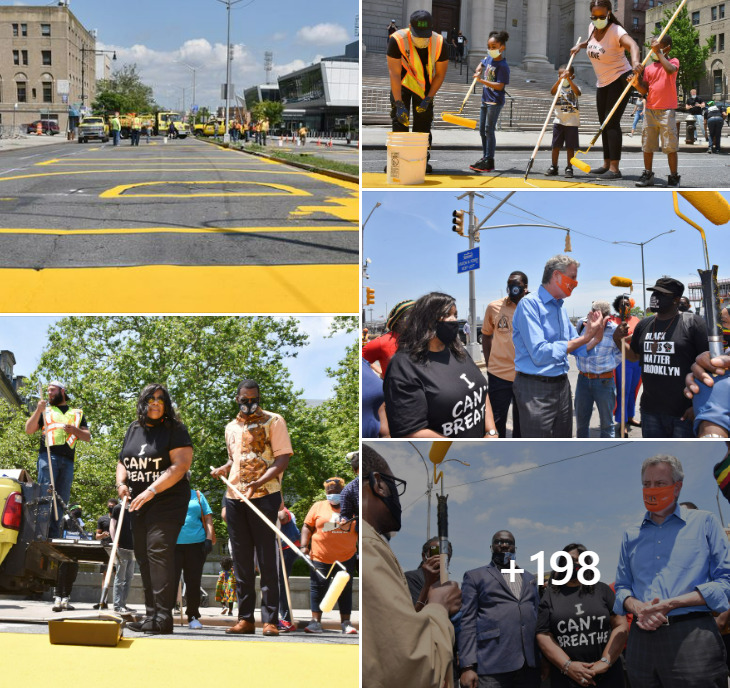 September 2, 2020
September 2, 2020BLM
BLM -
 2022-05-19
2022-05-19Everything You Need to Know About DC Black Pride 2022
This is a news story from Metro Weekly by Joseph Reberkenny. For the first time since COVID started, DC Black Pride will be back in-person. It is organized by the Center for Black Equity and it includes over 25 events highlighting the Black LGBTQ community in Washington. During the height of the COVID outbreak, the Center for Black Equity held events online instead. The organizers say that in-person events are special for this community and has planned safety precautions for people attending. There will be things like masks available at the event in addition to rapid test kits. -
 2022-03-28
2022-03-28A Voter Registration Rally & Vaccine Clinic
This is an Instagram post by whitneyfordekalb. This is an advertisement for people to attend a voter registration and vaccine clinic. It is calling on a few Black organizations in addition to unions to join the rally. Below are a few sponsors of the event. This event is in Georgia. -
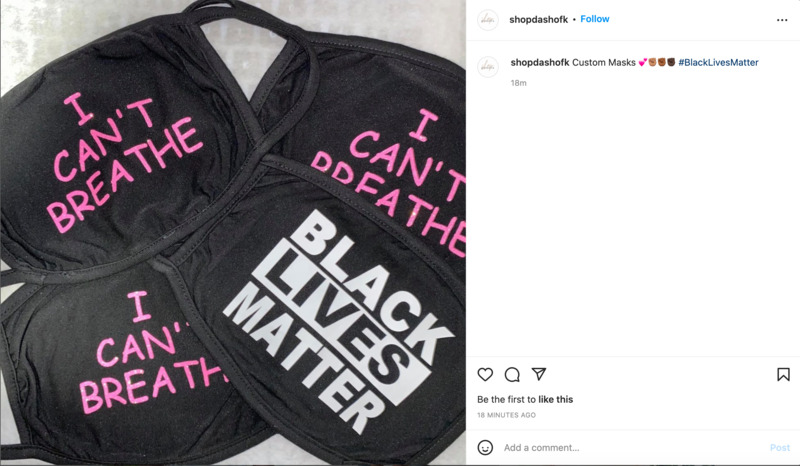 2022-04-11
2022-04-11Custom Black Lives Matter Masks
This is an Instagram post by shopdashofk. This is a post on custom masks with the words "Black Lives Matter" and "I Can't Breathe" written on them. These masks are meant to send a message on racial disparities between Black people and those of other races. Writing messages on masks has been a trend across all political spectrums, with some choosing different slogans or symbols to use, in order to send messages much like the masks featured here. This evokes some of the larger culture surrounding mask wearing in general, where they have been used much like graphic t-shirts to say messages people want heard. It is a new social phenomenon that has come with the pandemic, and it is still popular among some people. -
2020-05-10
LAST DANCE
The Pandemic put the sports world on hold just to make it one of the greatest turnouts ever. the first big event on tv during the Pandemic was the last dance. the last dance is about Michael Jordan's last year on the bulls. It felt like every human in the world was watching the tv screen. For some reason the documentary felt bigger than basketball. it served as hope for the masses. the back scene stories and the different perspectives reminded people that they can be great in their world. It was motivational in the time of need. And it provided hope and unity for the nation. it had a bigger impact than ever expect. then at the end its like what you expect goat documentary for the Goat of basketball [Watch The Last Dance | Netflix: https://www.netflix.com] -
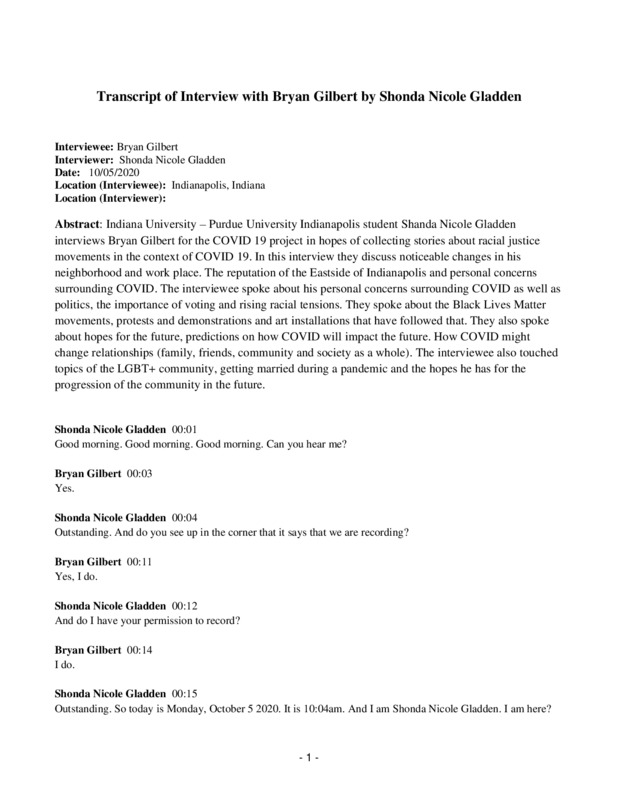 02/22/2021
02/22/2021Bryan Gilbert Oral HIstory, 2020/10/05
HIndiana University – Purdue University Indianapolis student Shanda Nicole Gladden interviews Bryan Gilbert for the COVID 19 project in hopes of collecting stories about racial justice movements in the context of COVID 19. In this interview they discuss noticeable changes in his neighborhood and work place. The reputation of the Eastside of Indianapolis and personal concerns surrounding COVID. The interviewee spoke about his personal concerns surrounding COVID as well as politics, the importance of voting and rising racial tensions. They spoke about the Black Lives Matter movements, protests and demonstrations and art installations that have followed that. They also spoke about hopes for the future, predictions on how COVID will impact the future. How COVID might change relationships (family, friends, community and society as a whole). The interviewee also touched topics of the LGBT+ community, getting married during a pandemic and the hopes he has for the progression of the community in the future. -
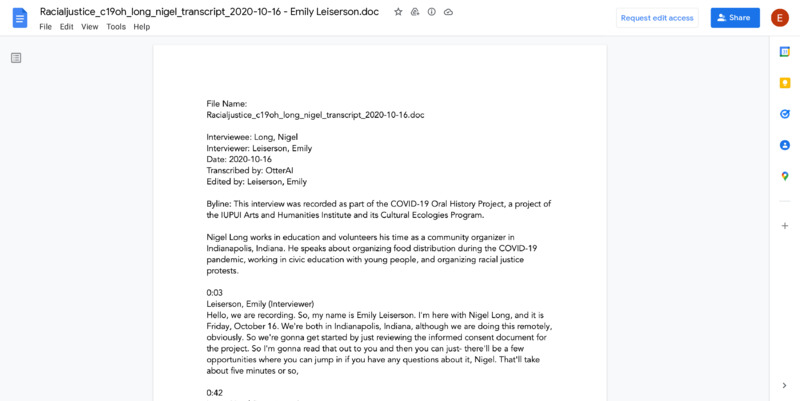 11/04/2020
11/04/2020Nigel Long, Oral History, 2020/11/04
Oral History is an interview with and educator to discuss taking up initiatives to combat social justice and police injustice that has occurred during the pandemic. -
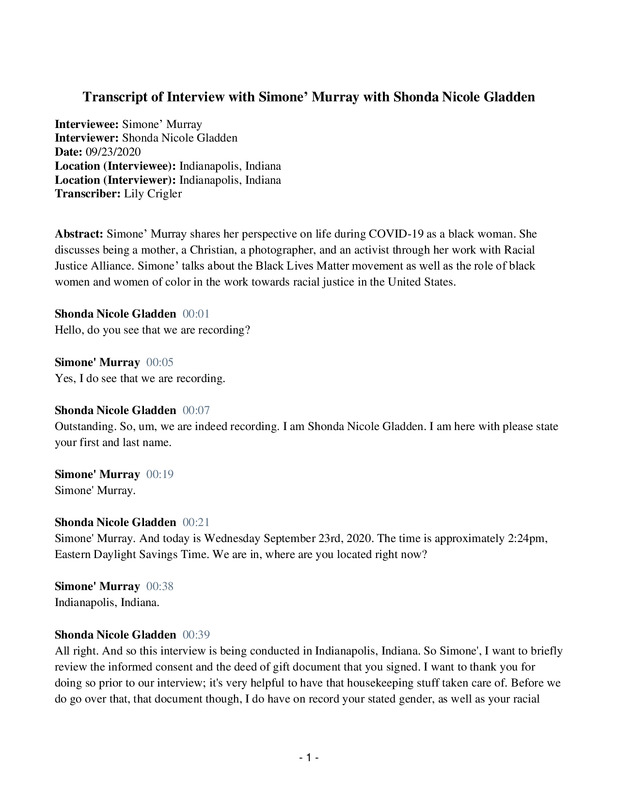 09/23/2020
09/23/2020Simone' Murray Oral History, 2020/09/23
-
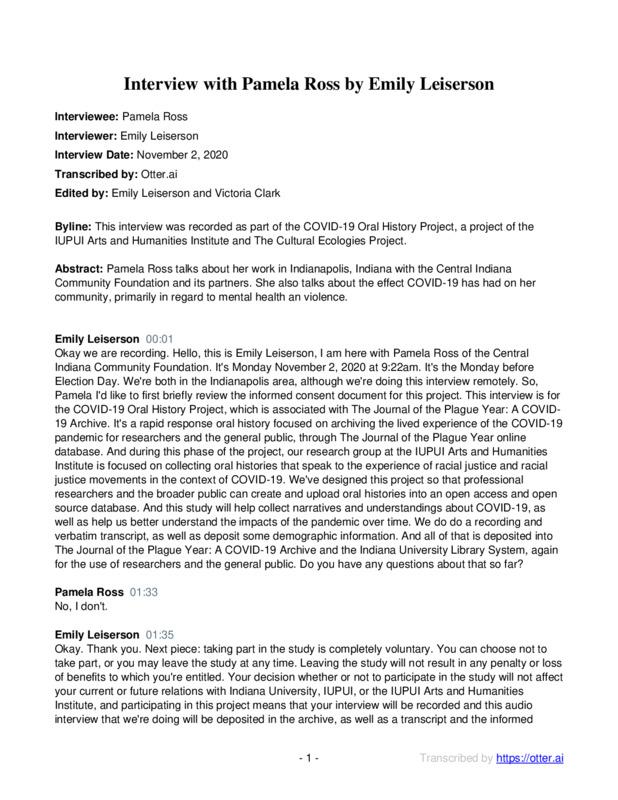 11/02/2020
11/02/2020Pamela Ross Oral History, 2020/11/02
This interview was recorded as part of the COVID-19 Oral History Project, a project of the IUPUI Arts and Humanities Institute and The Cultural Ecologies Project. -
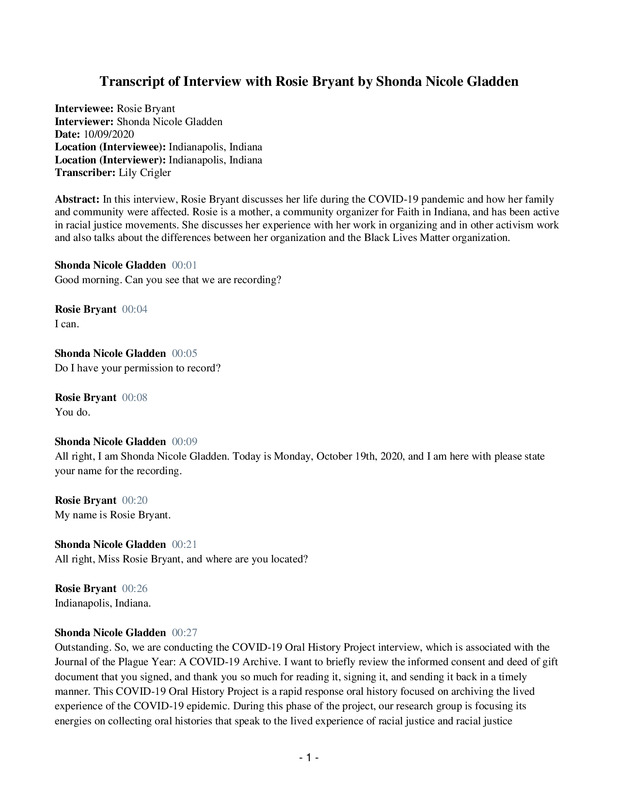 10/19/2020
10/19/2020Rosie Bryant Oral History, 2020/10/19
-
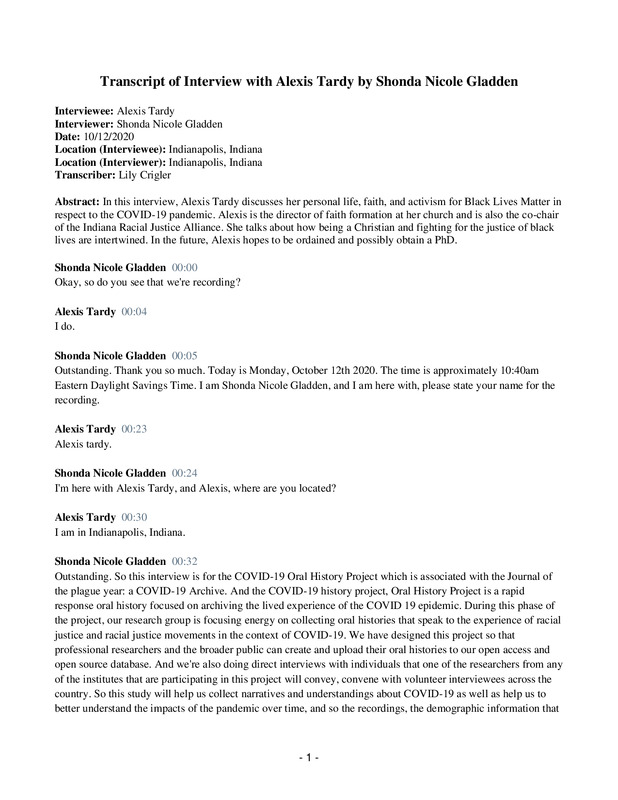 10/12/2020
10/12/2020Alexis Tardy Oral History, 2020/10/12
-
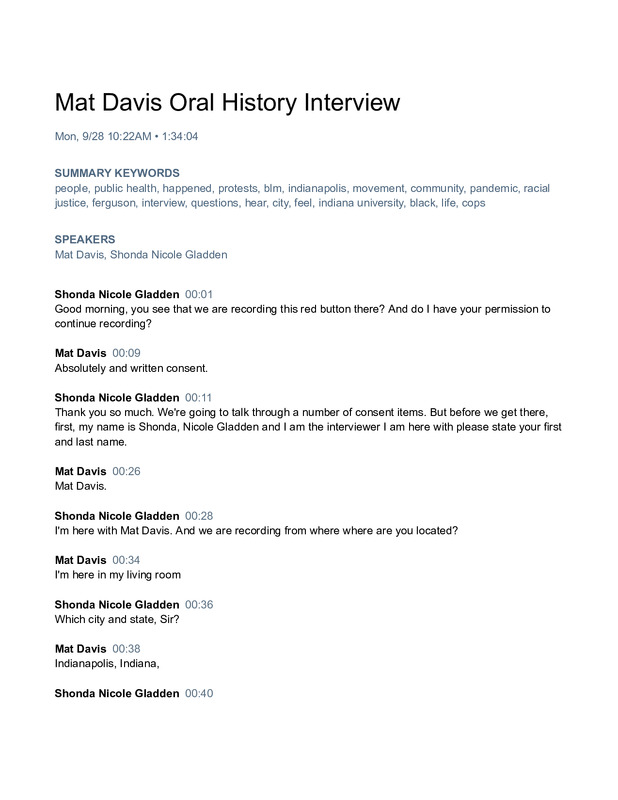 09/25/2020
09/25/2020Mat Davis Oral History, 2020/09/25
C19OH -
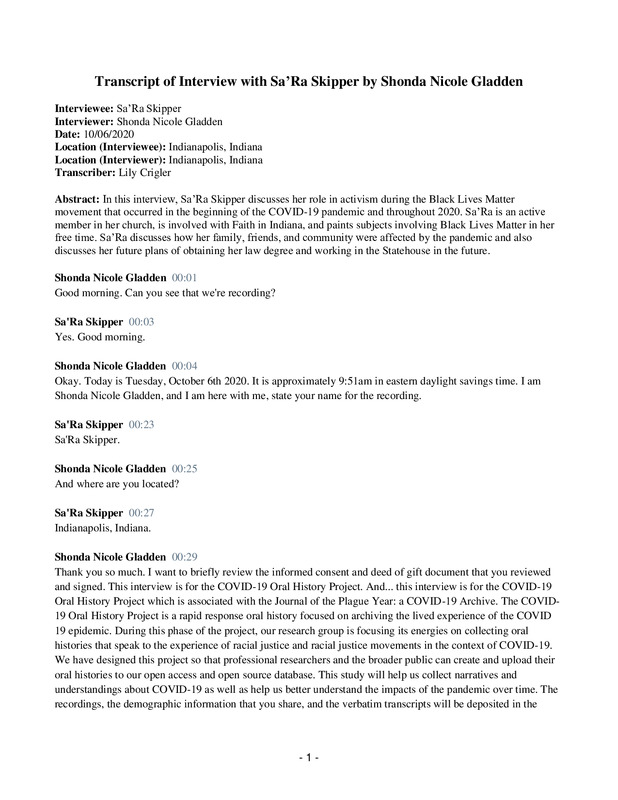 10/06/2020
10/06/2020Sa'Ra Skipper Oral History, 2020/10/06
-
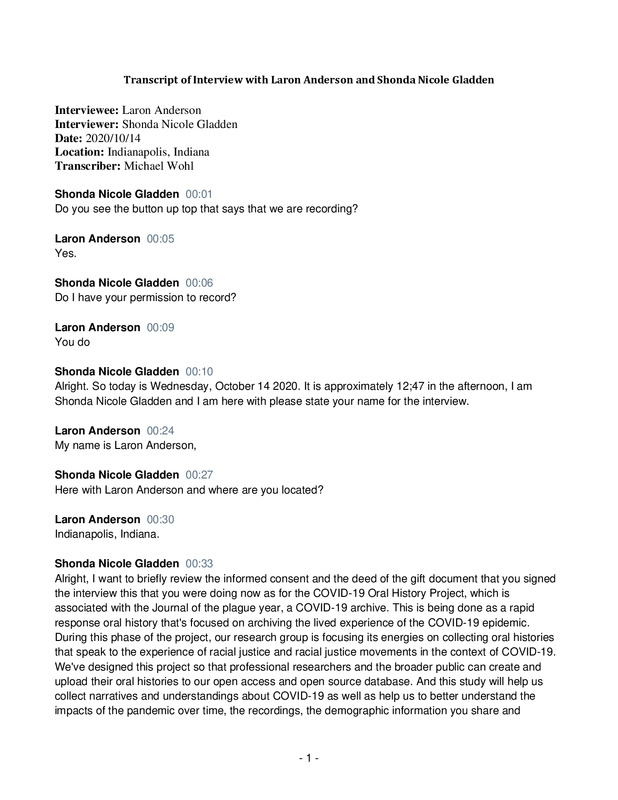 10/14/2020
10/14/2020Laron Anderson Oral History, 2020/10/14
-
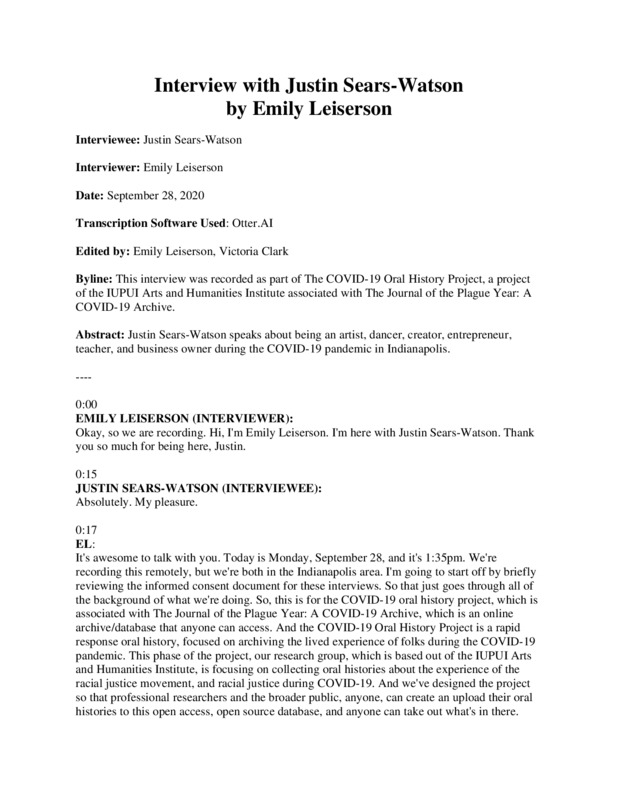 09/28/2020
09/28/2020Justin Sears-Watson Oral History, 2020/09/28
C19OH -
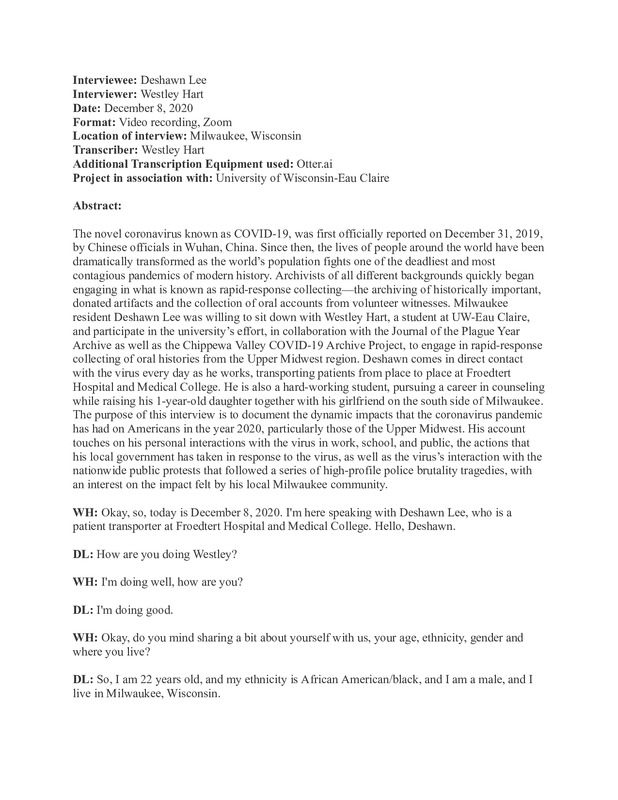 12/08/2020
12/08/2020Deshawn Lee Oral History, 2020/12/08
The novel coronavirus known as COVID-19, was first officially reported on December 31, 2019, by Chinese officials in Wuhan, China. Since then, the lives of people around the world have been dramatically transformed as the world’s population fights one of the deadliest and most contagious pandemics of modern history. Archivists of all different backgrounds quickly began engaging in what is known as rapid-response collecting—the archiving of historically important, donated artifacts and the collection of oral accounts from volunteer witnesses. Milwaukee resident Deshawn Lee was willing to sit down with Westley Hart, a student at UW-Eau Claire, and participate in the university’s effort, in collaboration with the Journal of the Plague Year Archive as well as the Chippewa Valley COVID-19 Archive Project, to engage in rapid-response collecting of oral histories from the Upper Midwest region. Deshawn comes in direct contact with the virus every day as he works, transporting patients from place to place at Froedtert Hospital and Medical College. He is also a hard-working student, pursuing a career in counseling while raising his 1-year-old daughter together with his girlfriend on the south side of Milwaukee. The purpose of this interview is to document the dynamic impacts that the coronavirus pandemic has had on Americans in the year 2020, particularly those of the Upper Midwest. His account touches on his personal interactions with the virus in work, school, and public, the actions that his local government has taken in response to the virus, as well as the virus’s interaction with the nationwide public protests that followed a series of high-profile police brutality tragedies, with an interest on the impact felt by his local Milwaukee community. -
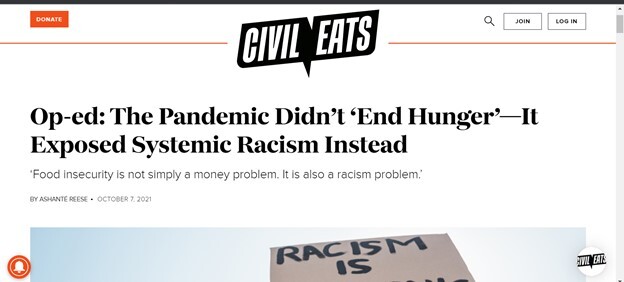 2021-10-07
2021-10-07Exposing Systemic Racism in all Areas
While some believed the pandemic aid solved food insecurity, that couldn't be further from the truth in black neighborhoods. -
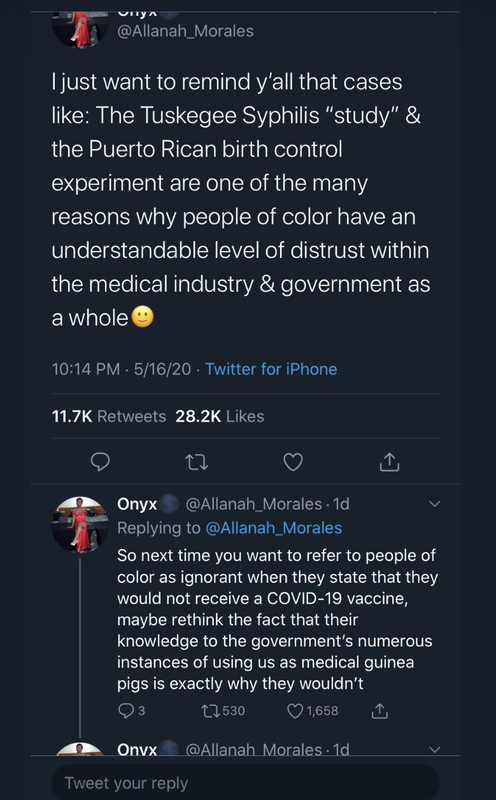 2021-05-16
2021-05-16Vaccine Hesitancy in the Black Community
This tweet reflects an ongoing controversy of the Covid-19 vaccine. The media has reported a hesitancy of the mRNA vaccine amongst the black community, but with little to no context on why there is such hesitancy. Based on the history of the U.S. public health institution, there have been reported inequalities that include a racial hierarchy within the medical system. This tweet specifies the instances of medical malpractice committed towards people of color and insists on an understanding of racial inequality through the lens of people of color that led to skeptical feelings about the vaccine. -
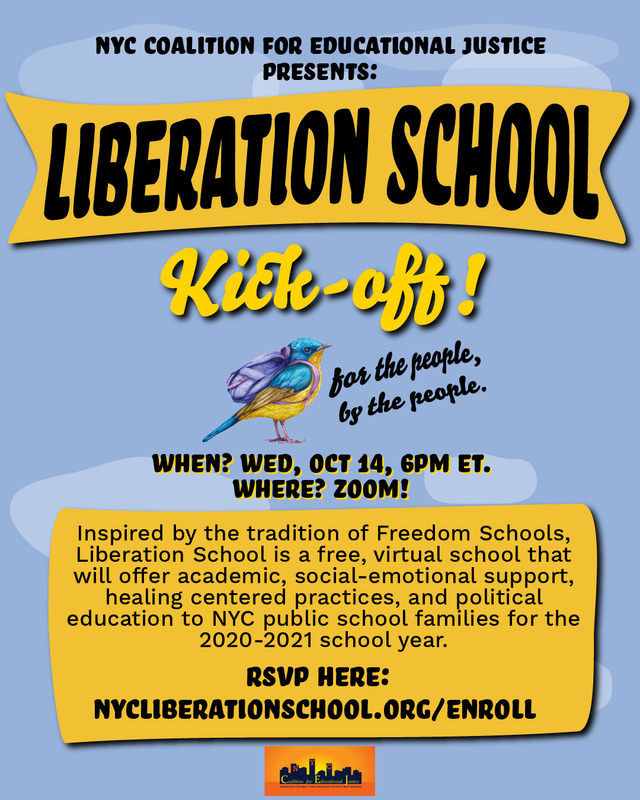 2020-10
2020-10Liberation School: the Mobilization of Back and Brown Parents, Healers and Educators
Liberation School was a free, virtual online school that offered academic support courses, social-emotional support, healing centered practices, and political education courses to NYC public school families throughout the 2020-21 school year. Created by the NYC Coalition for Educational Justice, the city's largest parent organizing group, Liberation school was designed as a response to the failings of the Department of Education to adequately provide the resources and support needed for marginalized students. While many principals, teachers and school staff put their hearts and souls into supporting NYC children during this global pandemic, it was clear that families could not solely rely on City Hall and the Department of Education to deliver a safe, quality education to children finishing out the 2020 school year and going into the 2020-21 school year. Black and brown students and families in New York City have faced the harshest, most devastating impacts of the COVID-19 pandemic and systemic racism. Previous inequities in the school system have revealed themselves and worsened. The Department of Education (DOE) and City Hall did not provide the necessary resources and support for parents and youth navigating remote and blended learning for the first time in a timely fashion or accessible to non-English monolingual families. While many white affluent families were hiring teachers to create learning pods, CEJ designed Liberation School for Black, Brown, Immigrant, and low-income families, who don’t have the financial resources to hire personal teachers or tutors. An important value that shaped the creation of Liberation Schools is the idea of what it truly means to be an ‘inclusive school’. Language Justice is also Educational Justice. CEJ created sessions accessible to the public in multiple languages. Through both multilingual instructors and simultaneous interpretations of English workshops, LS also offered sessions using commonly-used online platforms, outdoor spaces, and live streaming on social media. All courses that were culturally responsive in content and pedagogy and many were conducted in English and Spanish, and some workshops in, Bangla and Mandarin. CEJ was inspired by the tradition of Black Freedom Schools in the 1960s. After Brown v. Board, many schools were still segregated and led to many student movements organizing and fighting for true integration in Northern Cities like Chicago, Boston, and NYC. The first examples of Freedom Schooling were created in the North as an alternative space for students to go to during boycotts in 1963 and 1964. One of most prime examples of Freedom Schooling were the Freedom Schools created by the Student Nonviolent Coordinating Committee (SNCC) in Mississippi. Freedom Schools provided an educational experience for young Black Mississippians to challenge the myths of society, find alternatives to the segregated and racist white supremacists society, to understand the conditions of their oppression, and to create directions for actions in the name of Freedom. There were three general areas for the curriculum of Freedom Schools. One was academic work, which centered around the needs/or interests of the students that incorporated their real life experiences and learning about Black History or understanding the structural institutions. There were also creative activities such as writing, journaling, or arts. The last area was on developing leadership skills and helping students be a part of the change in society. -
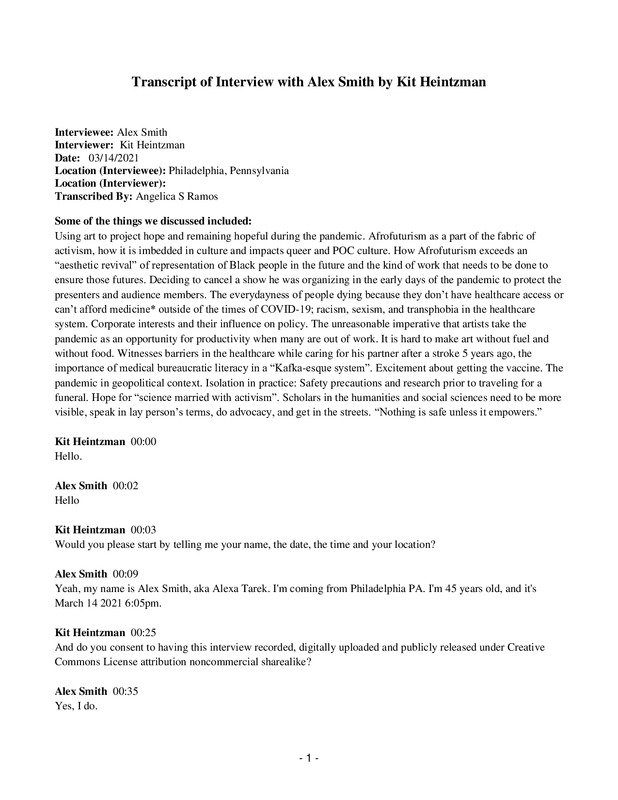 2021-03-14
2021-03-14Alex Smith Oral History, 2021/03/14
Self-description: “I’m an artist, writer, musician, and an off-and-on again activist, lecturer, worshopshop leader. I’m coming out of Philadelphia. My work revolves around concepts relating to Afrofuturism; for lack of a better term: superheroes and the conceptual nature of superheroes and the idea of the vigilante and the people’s champions and heroes can walk among us. I use [aesthetics and the immersive ideas of] from science fiction, cyberpunk, solarpunk, biopunk, and Afrofurturism to empower people of color, queer people and to project us into the future and our ideas and culture into the future as well. I use different mediums to do that, my bands Solarized (a sort of noisy punk rock band) and Rainbow Crimes (indie rock, but a little crazier and noisier than many excursions into that). I have written a short story collection called ARKDUST. And I do collage work and soundscapes and curate events like Laser Life, which was a queer sci-fi reading that me and my friends in a collective that I’m in called Metropolarity put together. That’s my praxis right now: a little bit of everything. I view my work as if I’m creating for 18 or 19 or 20 year old Alex, who probably needed some queer Black sci-fi in his life. So, I’m projecting these aspects of myself back to the past to not just nourish my community, but to nourish myself.” Personal website: alexoteric.com Other biographical details: Vegetarian, experiences depression, Pew Center for the Arts Fellow, during COVID is the first time in his life he’s had Health Insurance. Some of our discussion touched on: Using art to project hope and remaining hopeful during the pandemic. Afrofuturism as a part of the fabric of activism, how it is imbedded in culture and impacts queer and POC culture. How Afrofuturism exceeds an “aesthetic revival” of representation of Black people in the future and the kind of work that needs to be done to ensure those futures. Deciding to cancel a show he was organizing in the early days of the pandemic to protect the presenters and audience members. The everydayness of people dying because they don’t have healthcare access or can’t afford medicine* outside of the times of COVID-19; racism, sexism, and transphobia in the healthcare system.Corporate interests and their influence on policy. The unreasonable imperative that artists take the pandemic as an opportunity for productivity when many are out of work. It is hard to make art without fuel and without food. Witnesses barriers in the healthcare while caring for his partner after a stroke 5 years ago, the importance of medical bureaucratic literacy in a “Kafka-esque system”. Excitement about getting the vaccine. The pandemic in geopolitical context. Isolation in practice: Safety precautions and research prior to traveling for a funeral. Hope for “science married with activism”. Scholars in the humanities and social sciences need to be more visible, speak in lay person’s terms, do advocacy, and get in the streets. “Nothing is safe unless it empowers.” Other cultural references: Netflix, Zombie Movies, Sabrina the Teenage Witch, Oprah’s interview with Meghan Markle and Prince Harry, Black Panther, Teenage Bounty Hunter, Elon Musk, GoFundMe. A specific reference is made to the need for his sister’s sickle cell anemia medicine in this interview. She dies a few months later. The GoFundMe to cover funeral expenses can be found here: https://www.gofundme.com/f/memorial-fund-for-elizabeth-graham?utm_campaign=p_cp_url&utm_medium=os&utm_source=customer -
 2021-03-31
2021-03-31Gyre Oral History, 2021/03/31
Self-Description: “My name is Gyre. I am a multidisciplinary artist based in South Africa with global ambitions. I specialize in music, but I also work as a freelance writer as well as in dance. I’m a dancer learning to choreograph. Political commentator, particularity with regard to the LBGTQA+ community. I identify as queer. I am homoromatic and homosexual at this point in my life. You never know honey, it’s a spectrum. I had my first venture into artistic expression that is rooted in queer rights and queer understanding and queer theory, was my debut album, titled Queernomics, which was a documented audio-visual book about the contemporary experiences of a Black queer South African male, and that has gotten me into the positions that I express myself in, both out of passion and out of profession. Inkosi Yenkonkoni, which means “The Gay King”, in my native language which is Zulu.” Other details available here: Works produced during the pandemic: Kithi, International LGBTQ+ Rights Festival, writing on football. Some of the things we spoke about included: “What happens at the top is just politics, what happens at the bottom is real life.” Thinking about the term “pandemic” Listening to the body The pandemic exposing state corruption Having written a song called “Quarantine” in 2018 The inadequacies and privileges of Medical Aid in South Africa, having aged out of Medical Aid before COVID, the personal impact of worse-health insurance during pandemic, the importance of demonetizing health care Pre-COVID keeping busy: organizing, walking, collaborating Transit during COVID, sub/urban and outskirt disparities Canceling shows and taking dance classes and rethinking what it means to be productive Global Americanization and the impact of Trump’s pandemic denialism on South African health Moving out of disbelief about the severity of COVID after losing a loved one in the first wave Gratitude for the global influence of the Black Lives Matter movement, and sadness that tragedy in the diaspora brings neocolonialism to the fore The importance of social media for queer counter-violence and activist fractures among LGBTQA+ Feeling allyship with the #metoo movement How homophobia intersects with everyday altercations about social distancing The anxieties of hooking up during the pandemic The importance that scientists learn to speak in lay terms about climate change and vaccines Existence as resistance and creating art “Spread love not tolerance” Other cultural references include: Trans Day of Visibility, astrology, and the TV series Pose. -
 2021-03-08T12:38
2021-03-08T12:38Danny Denial Oral History, 2021/03/08
Self-description: “Audio visual artist that lives in Seattle, Washington, specifically in the realm of music and film, and also the intersection of the two. A lot of my work involves amplifying experiences and voices that are often underrepresented, primarily in the Black and LBGTQ+ community. And that’s something that overtime my work has been diving deeper and deeper into over the years, which is something that I think as an artist, I’ve only really come to terms with in the last few years. But it’s been definitely both empowering for me and illuminating to see it reflected back in the ways that people have responded to the work.” Other biographical details: late 20s, from Los Angeles. Some of the things we discussed include: The dysphoric experience of Black artists filtered through white talking points. Unstable work and income as an artist--audio and visual--pre- and mid-pandemic. 2019 was the first year that work as an artist and in performance communities was stable. Releasing the album Fuck Danny Denial in 2020 (https://dannydenial.bandcamp.com/album/fuck-danny-denial). Pandemic specific economic penalties of musicians in the case of live streams for Seattle Pride and Folsom Street Fair. The burden on artists to make ethical calls about canceling performances in the early stages of the pandemic, and needing to wear “new hats”, like health safety inspector. The pandemic as a shared experience of stoppage, and the need for adaptation. Aging and changing awareness about one’s needs for health care. Working to build equitable opportunities for artists. Since 2015-2019 doing gigs and video projects on contracts. Media outlets’ poor representations of the summer protests, acts of civil disobedience, and the autonomous zone in Seattle. Funding the serial project Bazooka (http://web.archive.org/web/20210622155802/https://ca.gofundme.com/f/dannydenialbazzooka) The ethical decisions associated with wanting to participate in amplifying and uplifting the BLM movement without exploitation for personal gain, engaging as a citizen. Witnessing a friend’s experience of hospitalization due to COVID-19. The value in studying patterns of human friendships and how the pandemic disrupted the conditioning of existence and the importance of local histories of resistance in Seattle. Cultural references: Pan’s Labyrinth, Smash Mouth’s super spreader event, Portland International Film Festival, The Tape Deck Podcast, Punk Black, Darksmith, Taco Cat, Alice and Chains, Duff McKagan, Pearl Jam, MoPOP, Shaina Shepherd, and TheBlackTones. -
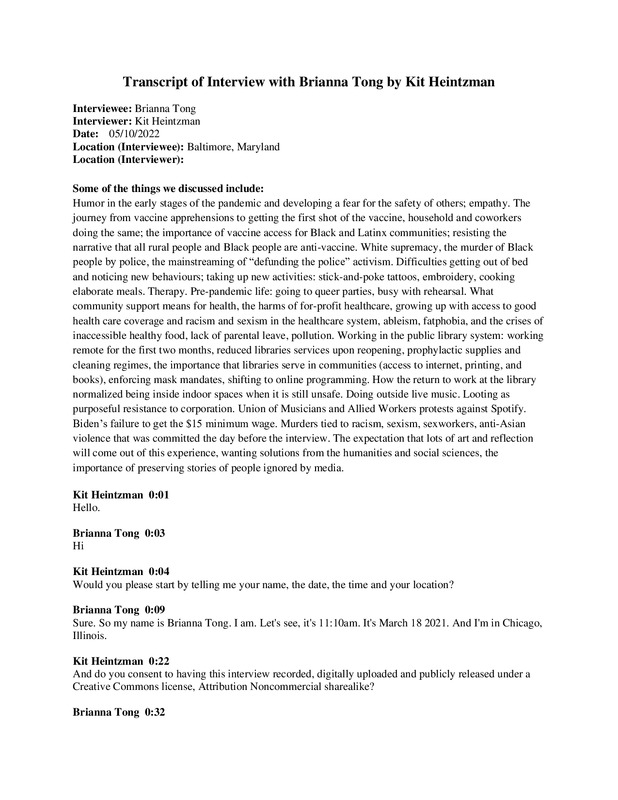 2021-03-18
2021-03-18Brianna Tong Oral History, 2021/03/18
Self description: “I am sitting in my bed right now as I’ve done for a lot of this quarantine. In regular times and I guess still now, I’m in three bands and I also work at the library, the public library. So I’ve been working there in person since we came back to work in May. I was contacted for this interview through Bussy Kween Power Trip, which is a Black queer punk band with three people, no guitars, so my close friends. I’m in two other bands. One band is called Je’raf and one is called Cordoba. And one person each from Bussy Kween is in each of those bands. Haven’t played a show in forever. I can give a little about what I look like or am like. I’m a woman. I’m 26, almost 27 I guess. I’m Black and Asian. I’m kinda short. And during this pandemic I’ve been in general super lucky to have a job still and a great living situation. And I met my partner right before the pandemic, so we’ve been chilling a lot and that’s been amazing. She is so great. Yeah, just going to work and working on all kinds of things in my home. And sometimes having the energy to do a bunch of music and crafts and other art things, and sometimes laying in bed for a full day.” -
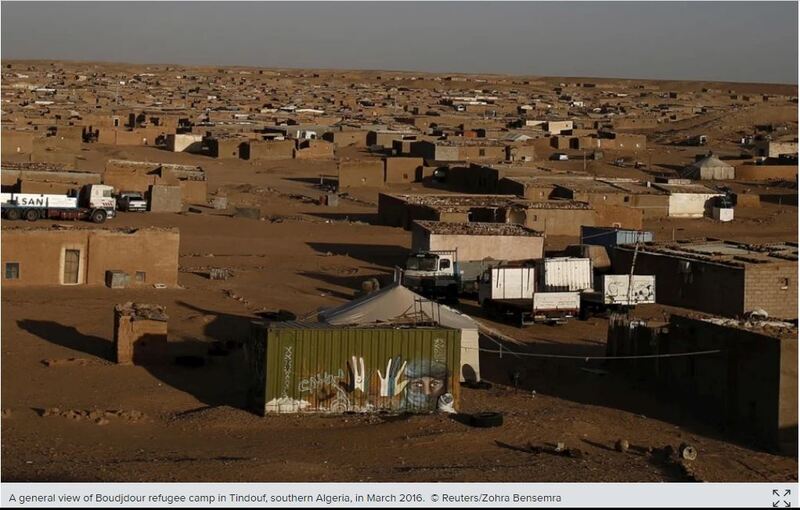 2020-09-01
2020-09-01Sahrawi refugees in COVID-19 lockdown hit by livestock epidemic
Refugees from Western Sahara in camps in Algeria’s Tindouf province lose animals to livestock epidemic, while coronavirus restrictions wipe out other means of income. -
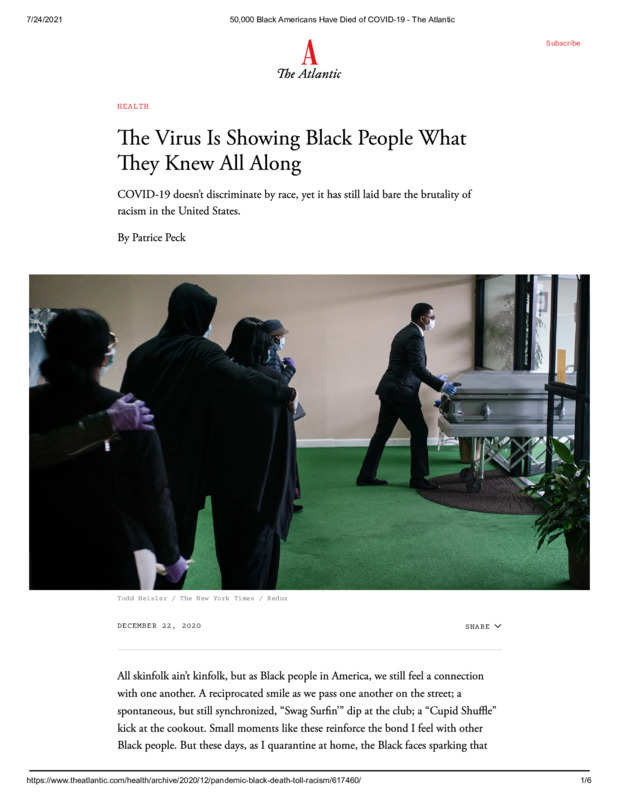 2020-12-22
2020-12-22The Virus Is Showing Black People What They Knew All Along
In this article, author Patrice Peck discusses how black Americans are dying of COVID-19 at 1.7 times the rate of whites. In her words "19,000 Black people would still be alive if not for systemic racism." -
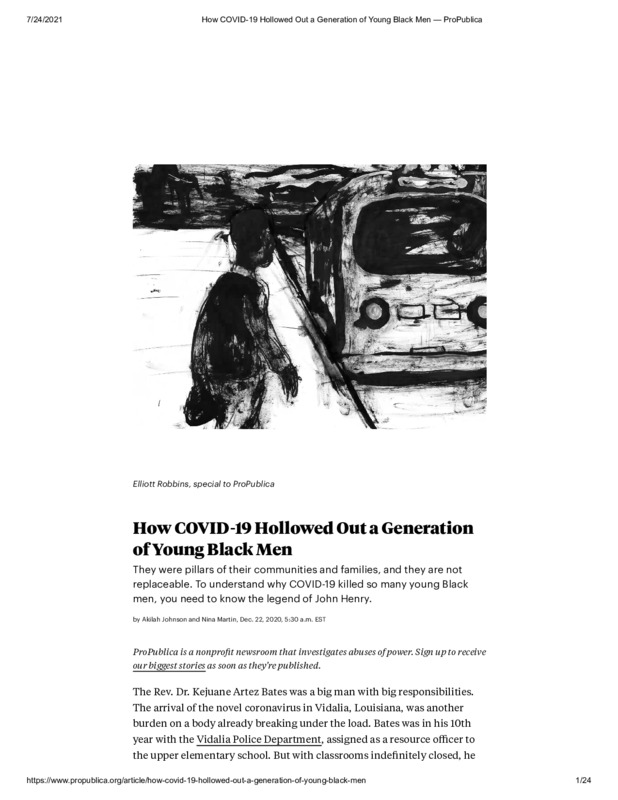 2020-12-22
2020-12-22How COVID-19 Hollowed Out a Generation of Young Black Men
This is a fascinating and heartbreaking article about the struggles of young black men and health inequity brought to light by COVID-19. The difficulties of systemic racism are costing young black men their lives. -
 2021-03-07
2021-03-07The COVID Racial Data Tracker
This data tracker showed how Covid-19 disproportionately affected black, Latinx, and indigenous communities. -
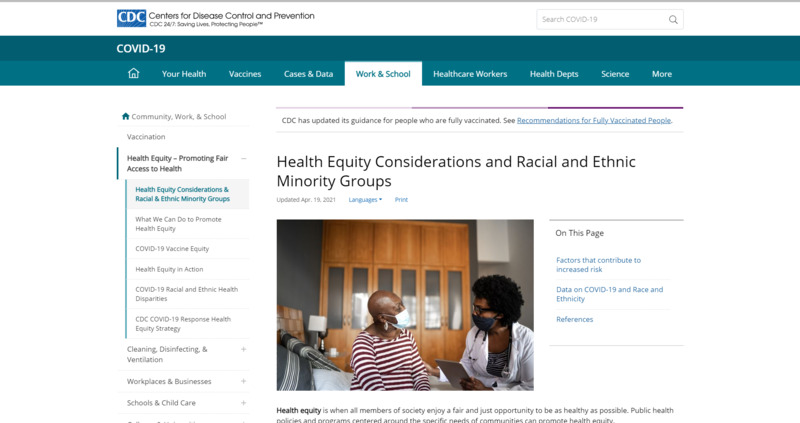 2021-04-19
2021-04-19Health Equity Considerations and Racial and Ethnic Minority Groups
The pandemic has brought the issue of health inequity in the United States, based on factors such as race and ethnicity, to the forefront. Racial and ethnic minority populations make up a disproportionate essential workers. Poverty restricts access to health care for many individuals. The country must address these issues of health equity and social justice now and continue to address it t ensure the health and safety of all those living in the United States. The website provides references, information, and data on the link between ethnicity and race and COVID-19. -
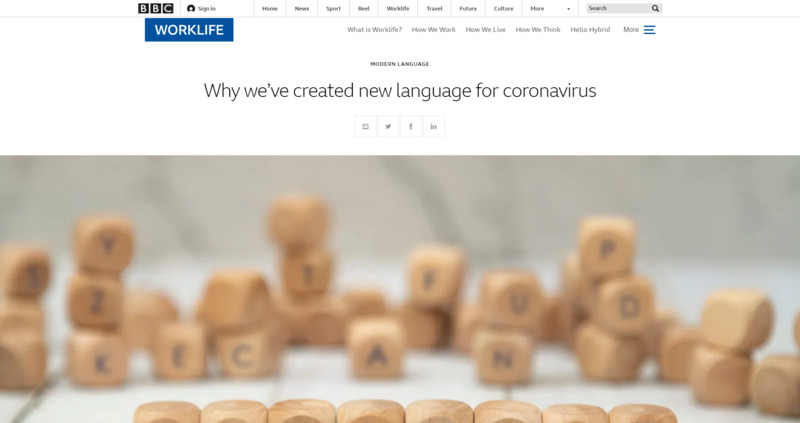 2020-05-24
2020-05-24Why We've Created New Language for Coronavirus
Language is ever evolving, and an event such as the COVID-19 pandemic has certainly led to new words and phrases in the English language and to new definitions for existing words and phrases. It remains to be seen which words that were coined during the pandemic will survive long-term and which ones will remain in a dictionary rather than in regular usage. This article, describing the English language from the British Broadcasting Corporation (BBC), describes changes in British, Indian, Canadian, and Australian English during these pandemic times. It discusses the speed of the linguistic change brought about by the pandemic and the coining of new words and phrases and new definitions of existing words and phrases. -
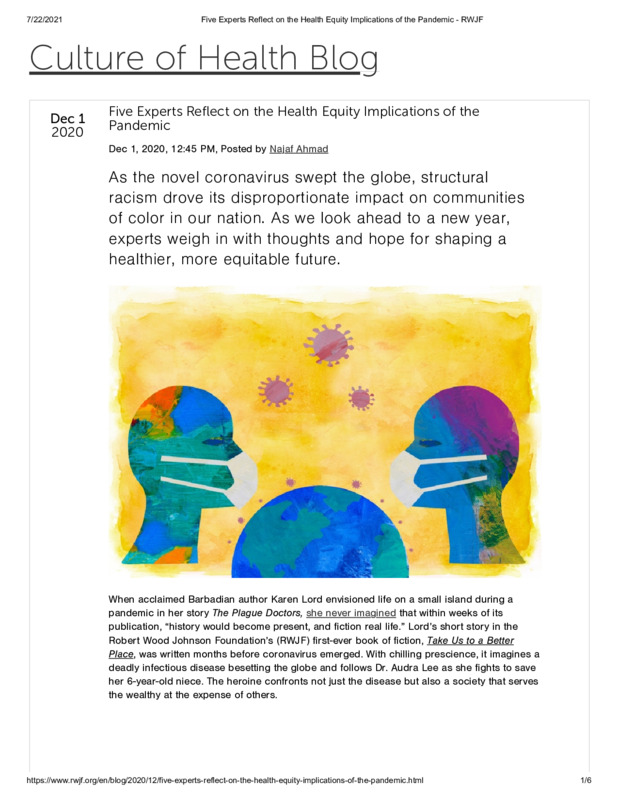 2020-12-01
2020-12-01Five Experts Reflect on the Health Equity Implications of the Pandemic
The Robert Wood Johnson Foundation Health Blog published this article which contains the words of 5 different experts on health inequity during the pandemic. -
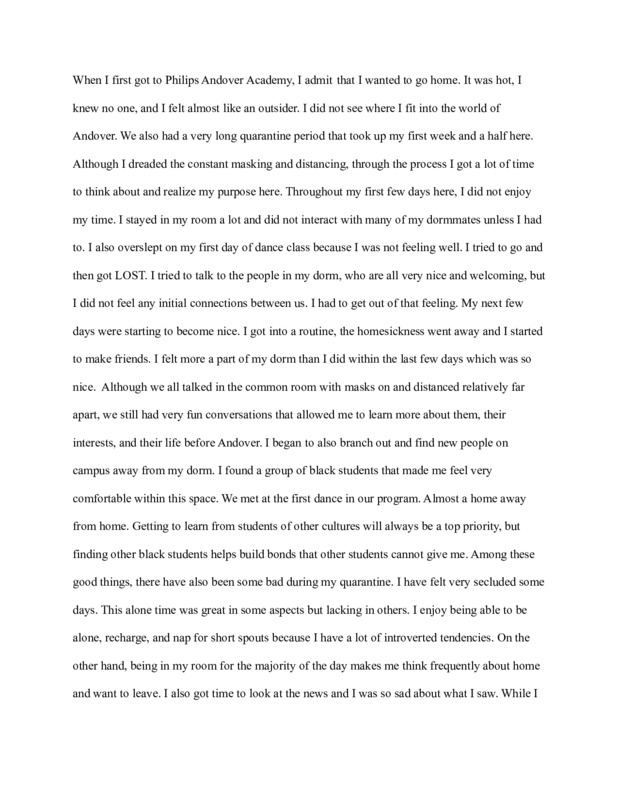 2021-07-10
2021-07-10Together, But Alone: Quarantine Life at Andover
My name is Maya Watt, I am 17 and I am from Memphis, TN. I am currently attending Phillips Academy Andover during their Andover Summer program before senior year. I have met many people, learned new things, and worked on my worth ethic. This is the story of my quarantine during my first week and a half at the camp. There are some highs and lows, but throughout my slightly rough quarantine/transition into the camp, I realized the purpose of my attendance at this school. -
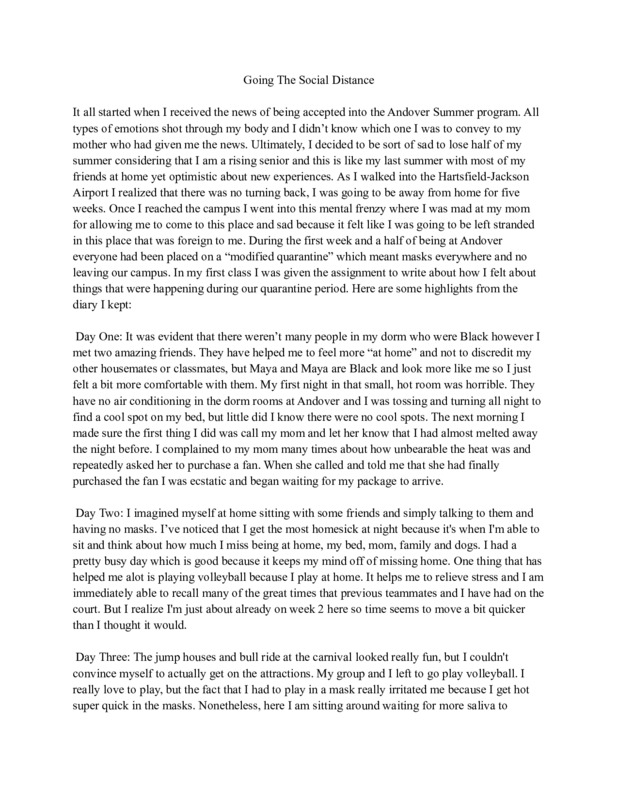 2021-07-10
2021-07-10Going the Social Distance
Over the course of about a week and a half I share my thoughts and feelings about the restrictions and rules we had while being placed on a modified quarantine. I discuss how it was to survive in the heat of summer, play volleyball, go to classes, and many other things while being masked up all the time. I tell readers about the testing I had to do so that everyone should know that I was negative for covid even. My story shows the different stages I've gone through throughout this modified quarantine. The stages being homesick to becoming comfortable embracing this experience of a lifetime. It is important to me because I'm using my real feelings and letting the readers know how I truly felt during the experience. -
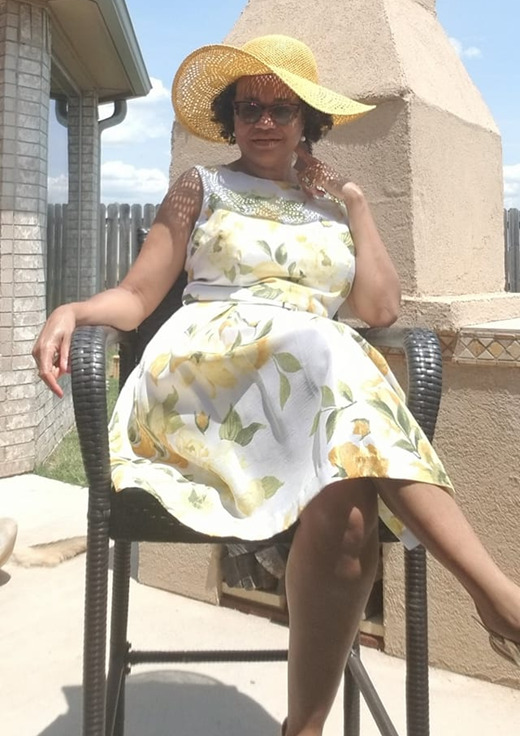 2020-06-24
2020-06-24Rediscovering a Family Passion
In the pandemic, Kimry reached back to her roots and decided to create a garden. When asked by friends on Facebook what did she put into the ground to make it so fertile? She replied "I put love into my ground, I put hope into my ground, I put patience into my ground and I put heart and soul into my ground. In life you can try and put this into people and yield no love back, no real friendship, and no real kindness. But, I tell you, Mother Earth will show you, that you deserve all that you put into her and more. God's time can be so quiet, calming, and so peaceful." -
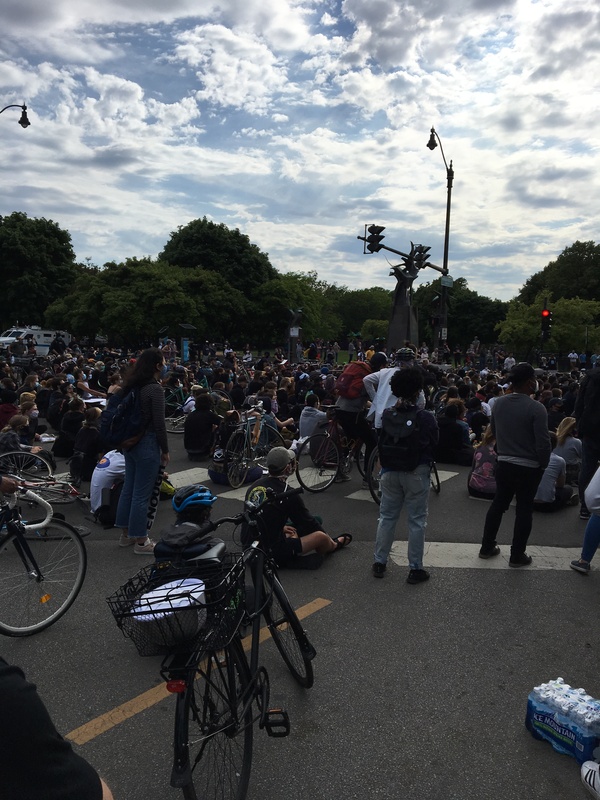 2020-06-01
2020-06-01June 1st 2020 Chicago Lincoln Park Protest
This was during the middle of the pandemic and I took a picture showing how not even a pandemic could stop people from uniting to protest against injustices. People can be seen wearing masks and keeping a bit of distance from one another considering. -
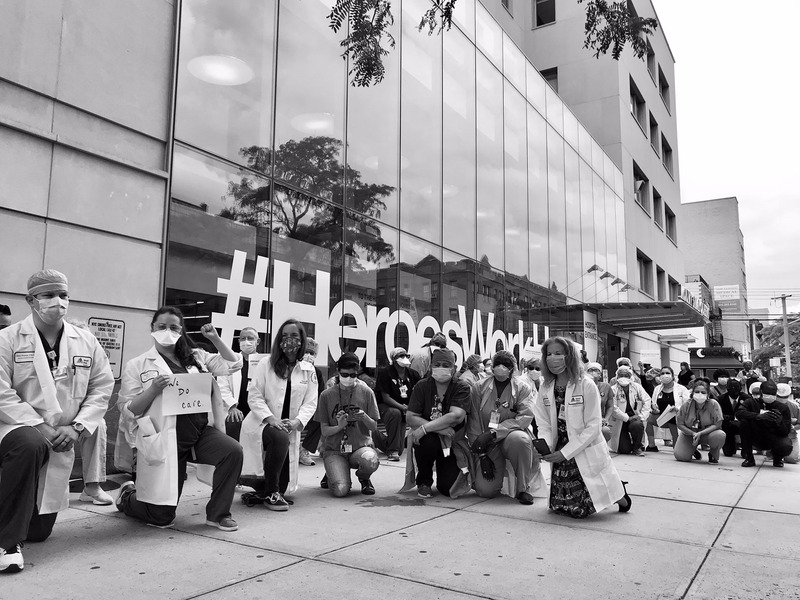 2020-05-02
2020-05-02On A Knee
The photo highlights a peaceful protest that involved the participation of medical faculty. The health care workers included in this photograph included doctors, nurses, admin, security guards and handful of maintenance. This was demonstration to support the Black Lives Matter Movement after the killing of a George Floyd at the hands of a police officer. The individuals in this photo can all be seen taking a knee similar to the protest method used by Colin Kaepernick. National Football League, player Colin Kaepernick took his first knee on September 1, 2016. The taking of the knee went against the tradition of standing during the signing of the National Anthem. Kaepernick said at the time: “I am not going up to show pride in a flag for a country that oppresses black people and people of color”. The people in this picture felt the same exact sentiments as Kaepernick. I chose this source because I wanted historians to understand the impact of the pandemic and the unity it created amongst individuals of different races. As a health care worker, I faced the challenges of Covid-19 directly. The fear of transmitting COVID-19 led to months of isolation from my loved ones. This feeling of loneliness contributed to the decline of mental health for me and many of my co-workers. On May 25, 2021, when George was murdered by a Minneapolis police officer over a suspicion of a counterfeit $20 bill my feeling of loneliness grew tremendously. Being an African American man in the united states was now just as dangerous as the virus killing thousands in New York. When the members of my staff came up the idea of protesting for the rights of African Americans, my feeling of loneliness begin to fade. Kneeling on the ground next to coworkers of all different races reminded of the inclusiveness and unity that we all needed in life. This was a moment in a history that will never be forgotten. -
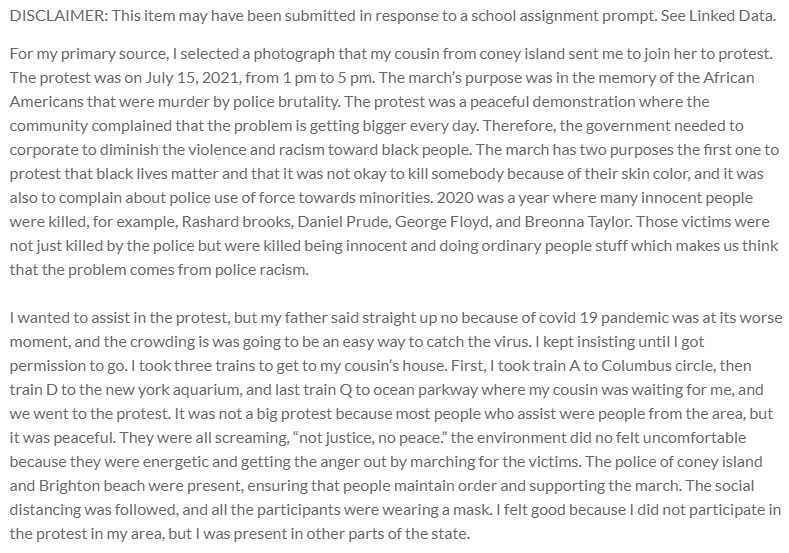 2020-07-15
2020-07-15Coney Island Police Brutality Protest
For my primary source, I selected a photograph that my cousin from coney island sent me to join her to protest. The protest was on July 15, 2021, from 1 pm to 5 pm. The march’s purpose was in the memory of the African Americans that were murder by police brutality. The protest was a peaceful demonstration where the community complained that the problem is getting bigger every day. Therefore, the government needed to corporate to diminish the violence and racism toward black people. The march has two purposes the first one to protest that black lives matter and that it was not okay to kill somebody because of their skin color, and it was also to complain about police use of force towards minorities. 2020 was a year where many innocent people were killed, for example, Rashard brooks, Daniel Prude, George Floyd, and Breonna Taylor. Those victims were not just killed by the police but were killed being innocent and doing ordinary people stuff which makes us think that the problem comes from police racism. I wanted to assist in the protest, but my father said straight up no because of covid 19 pandemic was at its worse moment, and the crowding is was going to be an easy way to catch the virus. I kept insisting until I got permission to go. I took three trains to get to my cousin’s house. First, I took train A to Columbus circle, then train D to the new york aquarium, and last train Q to ocean parkway where my cousin was waiting for me, and we went to the protest. It was not a big protest because most people who assist were people from the area, but it was peaceful. They were all screaming, “not justice, no peace.” the environment did no felt uncomfortable because they were energetic and getting the anger out by marching for the victims. The police of coney island and Brighton beach were present, ensuring that people maintain order and supporting the march. The social distancing was followed, and all the participants were wearing a mask. I felt good because I did not participate in the protest in my area, but I was present in other parts of the state. I selected this source because I want historians of the future to analyze that the country was active and acting against the problem. Racism is a global problem. It can be controlled if we unify and try to make others conscious that it is not okay to judge somebody else because of the way they look or their nationality. The communities were getting together to announce that they needed our support to solve the problem and eliminate conflicts with people equal like us but with a tiny skin color difference. Racism is so intense that people need to go outside in the middle of a pandemic to protest and moderate the issue. We were exposed to the virus because the violence toward minorities is increasing in the country. It looks like the only way it can be moderate is by going outside to show the dominant group that we have a voice. -
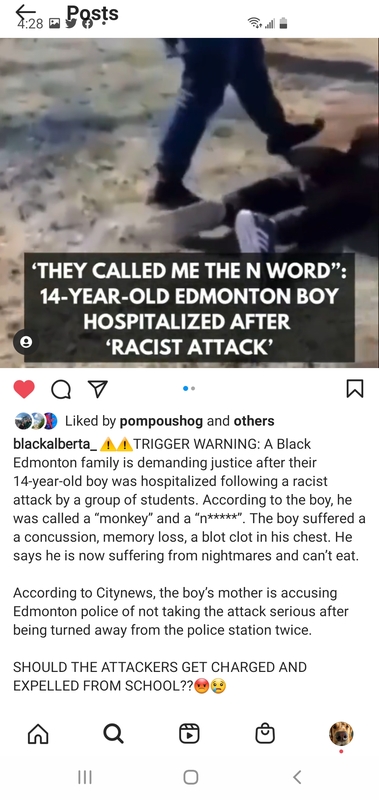 2021-04-24
2021-04-24Racist attack in Edmonton
On April 16th 2020, a 14 year old 8th grade student named Pazo was brutally attacked by seven white students. This attack was entirely racially motivated, they screamed slurs at him, beat him mercilessly, taunted him. They dragged him, choked him, and recorded their actions which they posted on social media. They attacked Pazo because of the colour of his skin, Pazo has stated after the attack that this assault has "made me afraid to wear my own skin." This is more than unacceptable, this is disgusting. As the post stated, these 'kids' gave Pazo a concussion, memory loss and a blood clot in his chest; he could of easily have been killed. What's worse, is there was no action taken by the school, which called this brutal hate crime a "altercation" by the school board. Ontop of this, the post states that the Edmonton Police also refused to investigate this assault, turning away the boy's family twice. This assault would of likely been swept under the rug if it were not for the pushback of the community, and the outrage generated by the presence of the video online. With the growing pressure from the public, the Edmonton police service are being demanded to investigate this assault, which again is only made possible through the pressure of the people. Furthermore, the lack of action and attempts to nullify the significance of this assault by the principal and the school board has resulted in students and teachers pushing for the forced resignation of those accountable, such as the principal and superintendent. Other social media platforms have stated that this is not the first time the principal of the school has played down similar incidents; which has left students feeling vulnerable. This cannot continue, these students must be held accountable - Albertans need to understand that white supremacism is a very real problem, and it is not going anywhere by ignoring it. As we have seen throughout the pandemic, events such as this are a rarity - we only know of the severity of the attack and the response of our education institutions because this attack was recorded and circulated online. -
 2020-06-19
2020-06-19Pandemic Street Art: collab by Menace and Resa
These are screenshots of the Instagram account that represents collaborative artwork by muralists Menace and Resa. The "UNITY" mural is in South Central Los Angeles, California and was done "in response to pandemic fueled anti-Asian hate crimes." The "More Justice, More Peace" mural is in Brooklyn, New York and memorializes Malcolm X and Martin Luther King, Jr. in celebration of Juneteenth. -
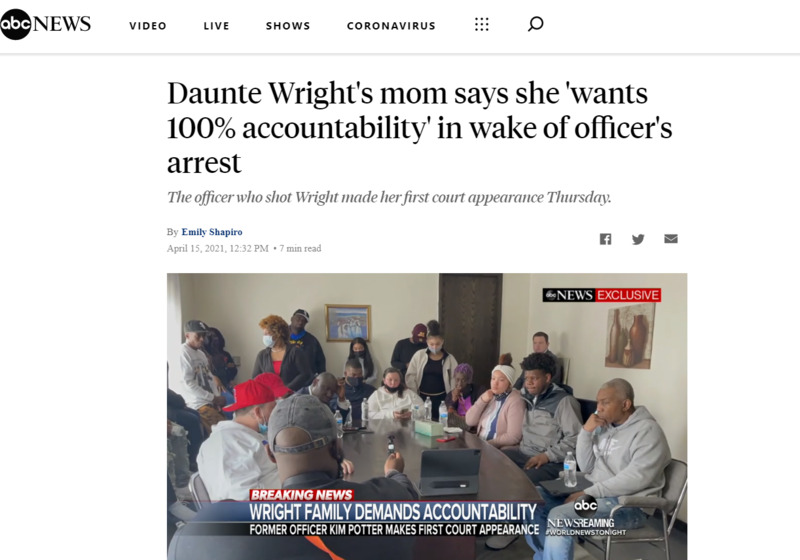 2021-04-15
2021-04-15Daunte Wright's mom says she 'wants 100% accountability' in wake of officer's arrest
The mother of Daunte Wright, the 20-year-old Black man shot dead by a Minnesota police officer at a traffic stop, said she "wants 100% accountability" in the wake of the officer's arrest. "If that even happens, we're still going to bury our son," Wright's mother, Katie Wright, said at a Thursday news conference. "We're still never going to be able to see our baby boy." -
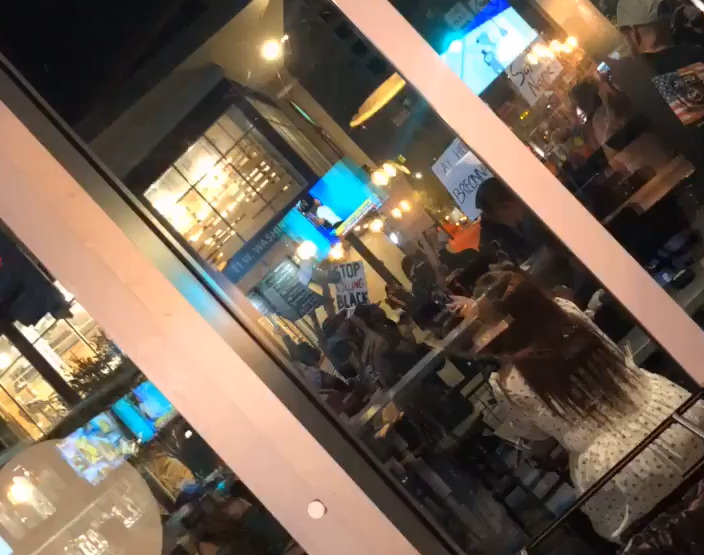 2020-09-23
2020-09-23The power of Gen Z
Living in the pandemic, I have seen my generation grow stronger together as we stand for the injustices occurring in this country. We have spread our ideologies onto social media to spread the message of unity and social justice to prevent further innocent lives from being taken. No violent or oppressive remark goes unseen or unheard of given the word is quickly spread around with social media. Living in the pandemic has allowed the spread of such powerful messages of unity and standing up for what is right to reach every corner of the country. While eating at a local restaurant in Downtown Phoenix, a small yet powerfully loud crowd of BLM protesters passed the location. Watching in awe and feeling some sort of empowerment, it came to my realization of how much these young adults’ voices have spread across the country. Watching the traumatic stories regarding George Floyd and Breonna Taylor (among the thousands of black lives that have been taken by police and civilian brutality over the past couple of decades), I began to fear for the safety of the black communities living in areas that began to pose threats for them. Similarly, I have watched and supported the protests against Asian American violence becoming very recurrent lately and have seen young adults like me speak out against it. Although I am a minority myself, I cannot understand the pain these families go through, but I surely stand by and support these communities. Watching this protest before me made me realize how powerful the second-youngest generation (Gen Z) has grown to be and will continue to blossom as we continue to stand with unity against oppression let it be against race or religion. Although this pandemic has physically separated us, it has also brought many minority communities to come closer and support each other with the hope of one day ending these targeted tragedies. -
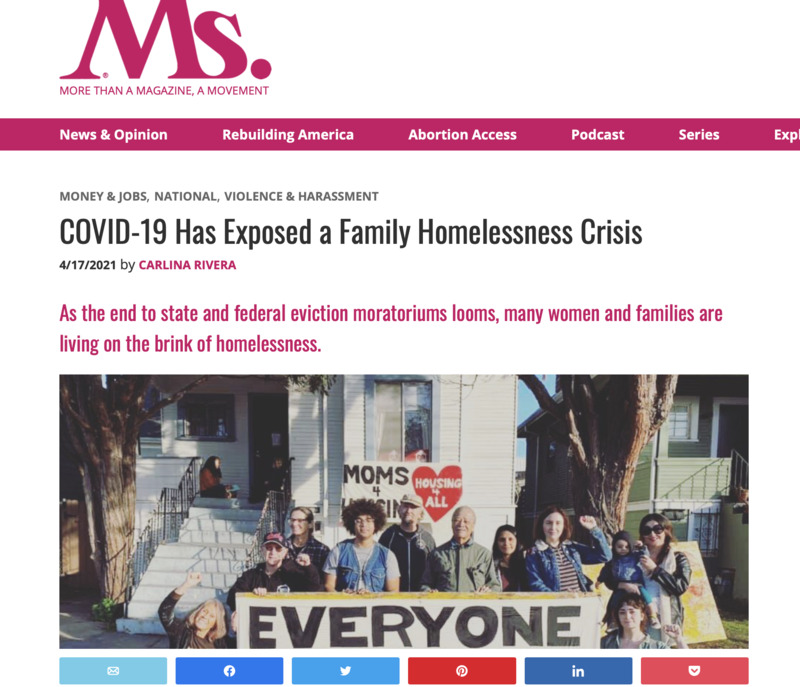 2021-04-17
2021-04-17The Crisis in a Crisis
This news article is about how COVID and homelessness have disproportionately affected families and especially black women. These are the two groups who are most likely to be benefitting from the rent moratorium right now. And as a result, they will be the groups most in danger of losing their housing once the moratorium expires. I wanted to include this story because it provides a perspective on homelessness that goes beyond people currently experiencing homelessness. People who are taking advantage of the moratorium are essentially on the verge of homelessness because they have no way to pay back that rent. This story highlights the fragile housing market and the economic situation that COVID placed many families under and the long-term economic consequences that come from this situation. -
 2020-06-27
2020-06-27Dialogue on Race
For my contribution, I would like to highlight one of the most publicized events that occurred during the first few months of COVID-19, the George Floyd killing and my actions to bring unity after. This incident put a spotlight on social issues that have been long swept under the rug, racism, racial violence and police brutality. During this time, members of the Air Force spoke out and initiated conversations about race, and racial disparities within our ranks. -
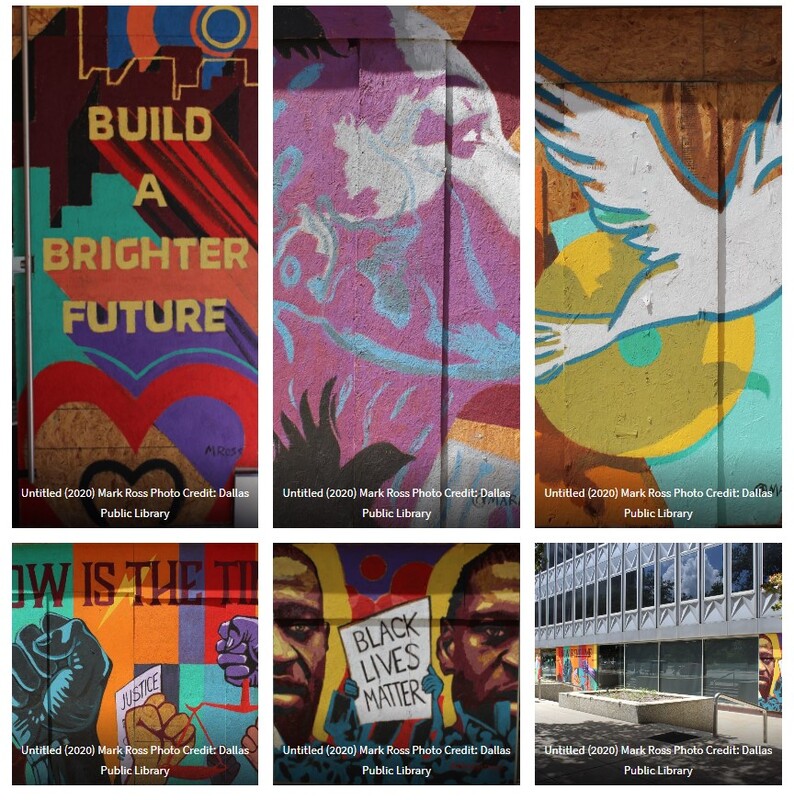 2021-01-16
2021-01-16Pandemic Street Art: The Black Lives Matter Movement and the Black Public Art Tradition (in three parts)
Author James Glenn writes, "From the New Negro Movement to the Black Power and Black Arts Movement to the Black Lives Matter Movement of today, public art created by black artists has served as communal visions of history, heritage, and hope. While it is important to highlight the work of contemporary black artists using their talents to push forward the antiracist demands of the Black Lives Matter Movement. it is imperative to understand that the current work of black artists is a continuation of the traditions black muralists initiated during the early to mid-twentieth century." This blog post explores the Black Public Art Tradition in three parts and includes an overview of Black Public Art during the COVID-19 pandemic. -
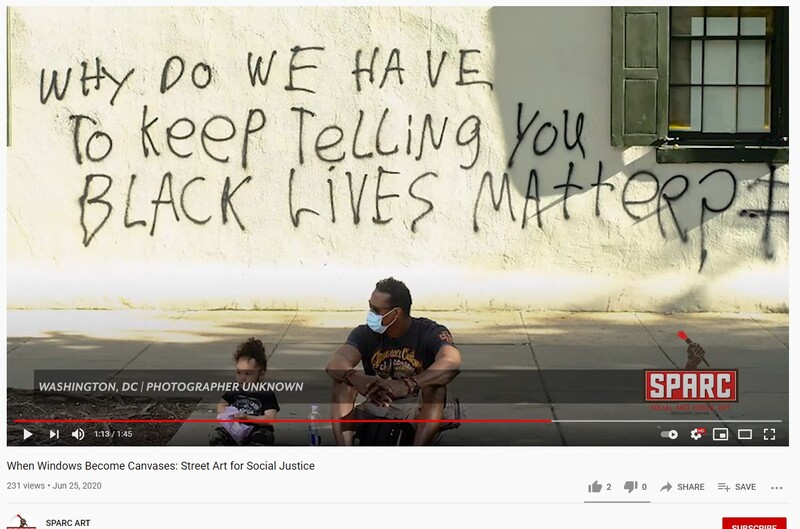 2020-06-25
2020-06-25Pandemic Street Art - When Windows Become Canvases: Street Art for Social Justice
This video by SPARC Art shows a variety of social justice-themed street art in the United States. -
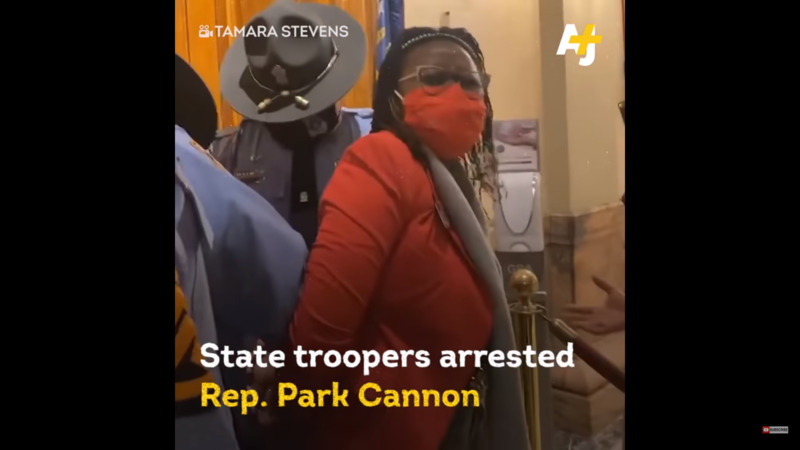 2021-03-26
2021-03-26Black Lawmaker Arrested For Knocking On Governor’s Office Door
State troopers arrested a Georgia lawmaker who was knocking on Gov. Brian Kemp’s office door, in protest of the closed-door signing of a bill that would restrict voter access. Critics, including Rep. Park Cannon, say the new laws will disenfranchise Black and Democratic voters. “I am not the first Georgian to be arrested for fighting voter suppression. I’d love to say I’m the last, but we know that isn’t true.” -
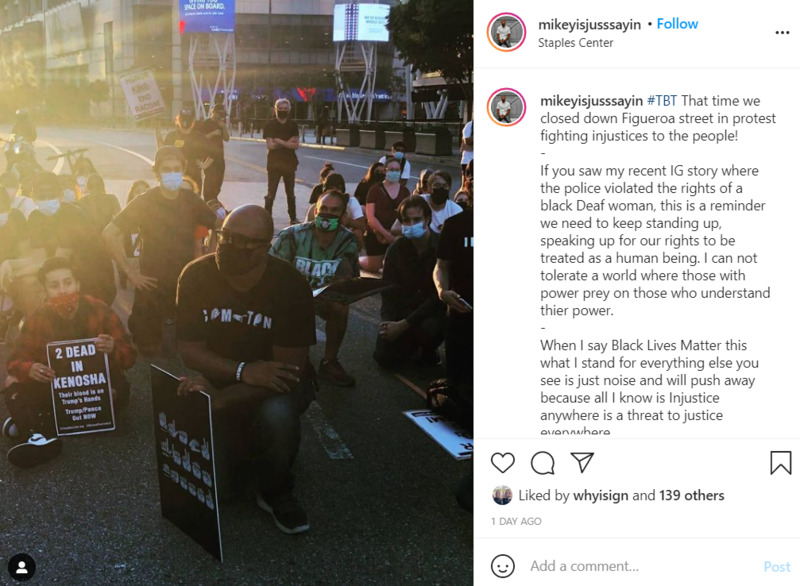 2021-04-09
2021-04-09That time we closed down Figueroa street in protest fighting injustices to the people!
#TBT That time we closed down Figueroa street in protest fighting injustices to the people! - If you saw my recent IG story where the police violated the rights of a black Deaf woman, this is a reminder we need to keep standing up, speaking up for our rights to be treated as a human being. I can not tolerate a world where those with power prey on those who understand thier power. - When I say Black Lives Matter this what I stand for everything else you see is just noise and will push away because all I know is Injustice anywhere is a threat to justice everywhere. - Stand with Me. Let's do our part to shape a better world. Power to the People all the time.✊🏿 - 📷 Gratitude @aanaconda -
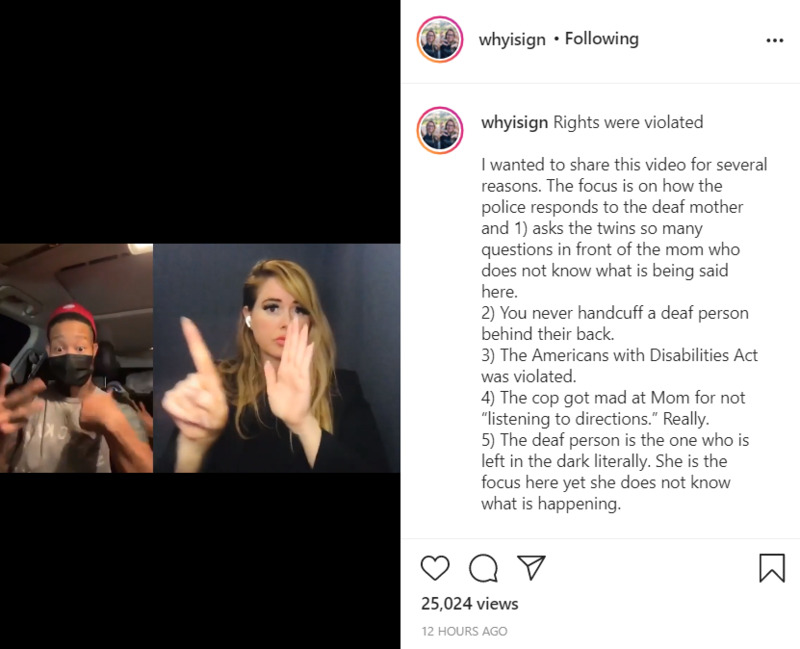 2021-04-09
2021-04-09Rights were violated
Rights were violated I wanted to share this video for several reasons. The focus is on how the police responds to the deaf mother and 1) asks the twins so many questions in front of the mom who does not know what is being said here. 2) You never handcuff a deaf person behind their back. 3) The Americans with Disabilities Act was violated. 4) The cop got mad at Mom for not “listening to directions.” Really. 5) The deaf person is the one who is left in the dark literally. She is the focus here yet she does not know what is happening. Unfortunately, this is too common in deaf and hard of hearing people’s experience with the police. This should not be the common experience in dealing with the police. There are more reasons, but the point is… this is one reason why the deaf people are so hesitant about getting help/support from the police. I hope this video as traumatizing, becomes a lesson. Police reform is much needed in so many areas, including learning how to communicate & how to work with deaf and hard of hearing people, the DO’s and the DON’Ts as seen here. I hope to see more training with the police departments in understanding how to work with deaf and hard of hearing people. I pray for healing for Mom- @burgundre Drizzy, and her twins. You can go and support her as she fights this. Trigger warning here. Posted @withregram • @kelly4access 11 year old twin girls are forced by police (Michael Rose of the North Las Vegas PD) to interpret for their deaf mom and are interrogated while she is handcuffed. @burgundre recorded recorded her encounter on FB Live. Thanks so much @dpantv for working late in the night to make this accessible!! #asl #captions #signlanguage #police #discrimination #injustice #ada #policebrutality #whyisign #askmewhyisign -
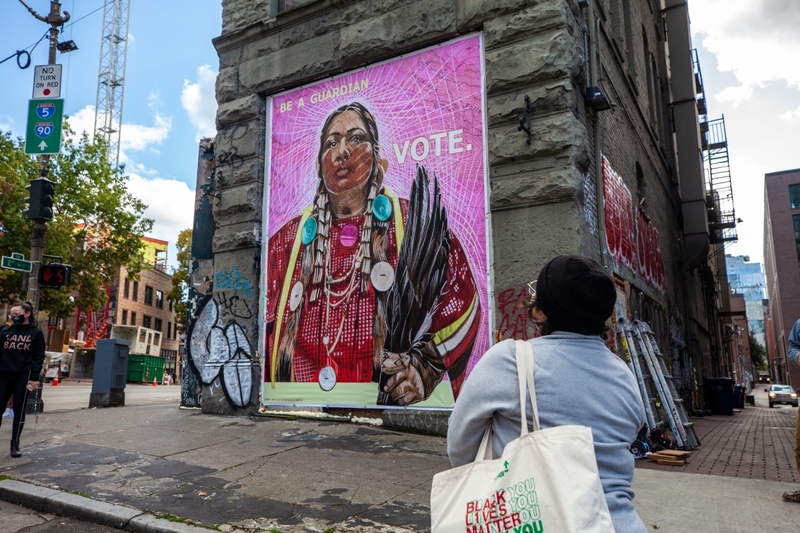 2020-10-28
2020-10-28Indigenous sovereignty and shared solidarity at heart of national art campaign
Indigenous land stewardship is a relatively new term, forged to compel more people to live in closer relationship with the land. As our world passes through multiple crises of our making, racial justice is the ultimate issue, and goal. As such, across many of the pieces commissioned by Nia Tero is the relationship between Black liberation and Indigenous sovereignty. A key message in these posters is the encouragement for people to get out and vote, use their voices to effect change on these critical issues and uplift diversity in leadership. The poster on the back of this newspaper page that you’re currently reading is part of a new series made in collaboration with Nia Tero, IllumiNative, and Amplifier Art, which debuted on Indigenous Peoples’ Day 2020 to elevate the work of Indigenous land stewardship, and to promote support of Indigenous peoples every day. The purpose of this collaboration is to demonstrate how coming together now, in this moment, is critically important for racial justice, climate action and collective liberation.
